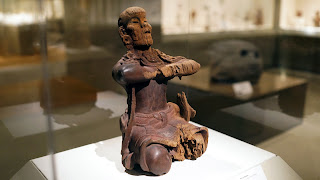Pottery and Clay FIgures - Jomon Period
https://smarthistory.org/japan-jomon-heian/
The Jomon period, between c.10,500 - c. 300 B.C.E, was Japan's Neolithic Period. The term neolithic is most commonly used in connection with agriculture and this is the case because during this time period many people obtained food by gathering, fishing, and hunting. It was also during this time period that the concept of crop cutivation and animal domestication was introduced.Similar to many other Neolithic cultures around the world, it was the women who were responsible for the earliest pottery and works of art with clay.
 |
| "Flame-rimmed" deep bowl from middle Jomon Period |
As the Jomon period progressed, the clay artpieces became much more complex in decoration and design. This would lead to the emergence of the Dogu doll.
These Dogu dolls are said to represent female figures that have exaggerated features. Some of the most common exaggerated features can be wide or googled eyes, a small waist, larger protruding hips, and in some cases a large abdomen which is said to be representative of pregnancy. Dogu dols were actually unique to the Jomon period. It is said that production of these dolls ceased by the 3rd century B.C.E. The neolithic period uses inmages of the female body as a strong symbol of fertility. Many of these pieces differed from one another and were completly unique to their region. A large amount of importance was placed on fertility, from the fertility of the women, to the fertility of the land newly exposed to agriculture.



These are some very interesting pieces! From the way they built the pottery and how they chose to decorate it and also the Dogu dolls and how they exaggerated the features of a woman. I'm slightly curious to why they ceased production of these dolls. Nice post!
ReplyDelete